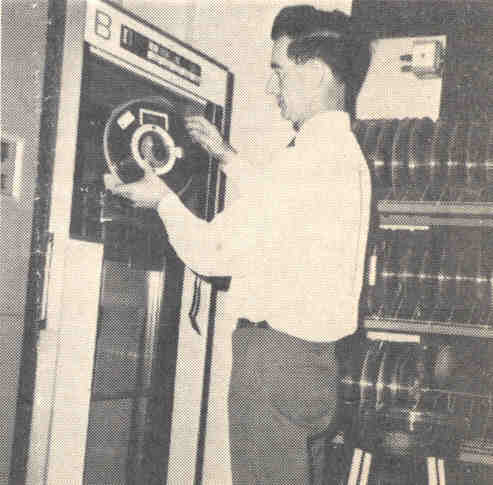

It is called Focus. And you've never seen a film quite like it before because it was made on a microfilm recorder operating from instructions generated by an ICL Atlas computer. The equipment is in the Science Research Council's Atlas Computer Laboratory at Chilton where it has been in operation for some months although not exclusively for the purpose of making films. Being mainly composed of lines, alphabetical: characters and symbols; computer films have more in common with cartoons than anything else, but it is possible to superimpose photographs as backgrounds to the line images.
Focus was made to describe the various facilities available to users of the system, and, illustrates such simulated camera and editing effects as zooms. wipes, straight cuts and a type of fade. Zooms are achieved by the basic cartoon technique of changing the scale of the subject in successive frames, while wipes and straight cuts are the results of its displacement. The fade is rather different from that normally seen in that the information or picture content appears in discrete or finite elements randomly distributed over the screen. With a standard fade the picture density changes uniformly over the whole scene.
One sequence deals with a computer programme for drawing contour lines over an area where heights at certain positions are known. In, a dramatic scene we see the earth rotating at one degree per frame, each frame the result of a calculation involving over eight thousand pairs of numbers representing the coastlines of the world. This then gives way to a sequence of the British Isles being drawn by stop motion The information used in this map utilizes even more points or pairs of numbers than that for the whole world, giving as it does much greater detail in the coastline.
These values were obtained using a digitizer or pen-fo11ower, a machine which automatically punches out the coordinates on paper-tape as a hand-held pen traces the outline. (It is, in fact, the holes on paper tape and cards that enable the programmer to feed in his instructions and data to the computer. The light transmitted by the holes in the readers activate electronic circuits which in turn store the patterns for further processing.) Finally, a zoom-in settles on the Atlas Computer Laboratory and a mix brings up the word END followed by an optical fade-out inserted at the printing stage by a commercial laboratory.
The film, made on 16mm, has a sound-track produced and recorded by a professional film maker who protested somewhat at recording sound at 16 frames per second. However, with full-track magnetic striping and the type of sounds recorded - I was persuaded to contribute a grunt in one sequence - the result was very satisfactory. And it saves on computing time as the standard sound speed is half as much again at 24 frames per second.

The recorder is designed round a. cathode ray tube similar to that used in a television set. Instead of performing a raster scan as in TV, the beam may be positioned at any point and deflected by various amounts at different angles. It is thus possible to draw objects previously specified numerically anywhere on the screen face. If these pictures are moved slightly in position and/or shape from one frame to the next, then animation is achieved when they are projected back through a cine projector. Each individual line or point is displayed sequentially on the tube; and as the 16mm cine camera is housed with the cathode ray tube in a light-tight cabinet, the shutter normally stays open until the complete picture has been built-up and recorded on the film.
The frame advances are. governed by instructions also supplied by the computer under programme control. These instructions, together with those that produce the lines and characters, are recorded by the computer on magnetic tape. The reels contain approximately 2,4OOft of tape, but have twice the width of that used on domestic tape recorders. This amount of tape can hold up to two million instructions for the microfilm recorder to operate upon. The machine plots points at something in excess of 3,000 per second and draws lines at a rate of over 1,000 per second. Yet even this rate sometimes appears slow, particularly when the line content of a scene is high and many frames are required. Words, for example, have to be made up from characters containing many lines. As computers become faster and microfilm recorders more widespread, many films or film sequences produced by this method will no doubt be seen; and since lines can be positioned through highly complex mathematical calculations carried out by the computer, the human animator will find them virtually impossible to match. On the other hand, the computer time required to perform simple shading or blocking-in of irregular shapes tends to be so long as to be prohibitive. It is probably in the field of teaching and scientific applications that the main demand will lie, although artists are also becoming increasingly interested in the computer means of self-expression.